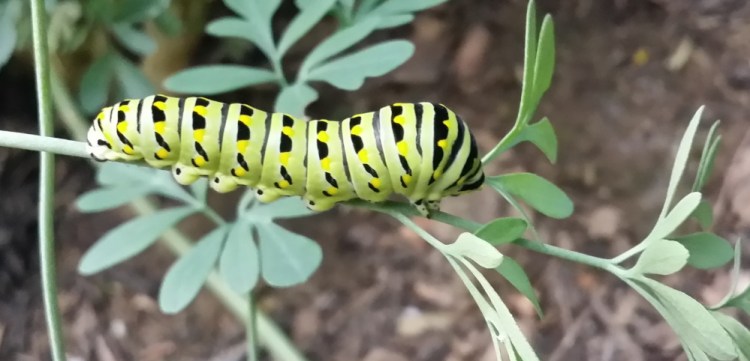There are good caterpillars and bad caterpillars. The good caterpillars are essential parts of the natural web that keeps wild creatures alive in our increasingly urban country. The bad caterpillars are damaging some of the native trees that, among other things, provide food for the good caterpillars.
The life of caterpillars was an oft-repeated topic at the Grow Maine Green Expo – conducted by the Maine Landscape and Nursery Association and Maine Arborist Association – last month at the Augusta Civic Center.
Let’s start with the good caterpillars.
Doug Tallamy, if he didn’t launch the movement of growing native plants necessary to support wildlife, spread the practice widely in his 2007 book “Bringing Nature Home: How Native Plants Sustain Wildlife in Our Gardens.” He discussed the good caterpillars in a packed lecture at the Expo.
Caterpillars are desirable for a lot of reasons: Many are beautiful in their own state; many turn into gorgeous butterflies and moths; and all of them are a highly nutritious source of food, not only for birds but for other wildlife, including amphibians and mammals. Although adult birds eat fruits and seeds, the only food many species of baby birds can eat is caterpillars. Caterpillars are soft, with almost no exoskeleton, and are high in protein and carotenoids.
So caterpillars and insects that are the later stages of caterpillars are important. And what do those species eat? Plants.
Not just any plants. They eat the native plants that co-evolved with the insects.
There is a reason for that. The plants don’t want to be eaten. As they evolved over the centuries, plants developed chemicals that make the leaves taste bad or otherwise repel predators.
The insects adapted, too.
“Host-plant specialists figured out how to get by chemical defenses of one or two plants and detoxify the compounds,” Tallamy explained. “And it takes a long period of time for those adaptations to take place.”
An example of adaptation is the well-known case of the monarch butterfly and milkweed, which young monarch caterpillars need to survive. The sticky white sap that gives milkweed its name oozes out when an insect eats, and the ooze forms a goo that sticks the insect’s mouth parts together, so it starves to death.
The monarch butterfly has developed a way to bite the stem of milkweed leaves, stopping the flow of the sap.
“The monarch is now able to eat a plant that is not available to other insects,” Tallamy said. The down-side is that without enough milkweeds around, monarchs could die out, which is why all gardeners are now urged to plant milkweed.
“Lack of milkweeds is a marketing issue,” Tallamy said. “We call them weeds. What if we called them Monarch’s Delight?”
Tallamy has spent a lot of time counting caterpillars. A white oak on his property in Delaware had 410 caterpillars at head height, which represented 19 species. A black cherry, also native, had 249 caterpillars, amounting to 14 species.
Nearby, Tallamy said, were some non-natives: 32 callery pears, hosting a total of one caterpillar; burning bush, four caterpillars, all the same species; gingko biloba had only a few caterpillars, and he thinks they were there by mistake because nothing eats gingko.
Overall nationally, oaks support native caterpillars more than any other plant, but in Maine the favorite plant for caterpillars is willow, followed by the oak. Trees overall are better than herbaceous perennials.
All of his information on caterpillars should have a big impact on gardeners.
Tallamy believes that every landowner has a responsibility to include native plants in her garden that support wildlife. It is the only way the birds and other wildlife we want – we need, as we are all interconnected and interdependent – in our ecosystem can survive. There isn’t enough public land to do the job. It is up to us.
Now on to the bad insects.
Colleen Teerling, an entomologist with the Maine Forest Service, discussed the browntail and gypsy moths, which are both major problems in coastal Maine.
But because her audience was mostly arborists, she had some details that were new to me.
Teerling’s talk followed Tallamy’s, so the audience was already enthusiastic about preserving native caterpillars.
In response to questions, she said that the chemicals that kill the invasive insects also kill the native ones. But because both the browntail and winter moth caterpillars come out early, spraying as soon as the leaves emerge might (and she stressed might) kill the pests without killing the natives.
Using systemic pesticides, which are injected into the tree, “will make the tree a desert,” killing all the insects that depend on it – the good and the bad.
One small ray of light: Teerling said that the release of flies as biocontrols to attack the invasive pests will work – but it will take time. Until then, such methods as tree banding for winter moths can provide a little help.
CHAMPS AT PLANTS
The Horticulturalist of the Year awards are announced every year at the Grow Maine Green Expo. This year, Chris Bales, a product representative at Casella Organics, a company that makes composts and does other recycling and environmental work, was named winner of the Al Black award as Horticulturist of the Year. Traditionally the award goes to someone who works with plants, but Bales has been active in Maine Landscape and Nursery Association projects for many years.
Lee Skillin, the latest in a long line of family workers at the family’s greenhouses in Falmouth, Brunswick and Cumberland, was named Young Horticulturist of the Year.
TOM ATWELL is a freelance writer gardening in Cape Elizabeth. He can be contacted at 767-2297 or at: tomatwell@me.com.
Send questions/comments to the editors.


